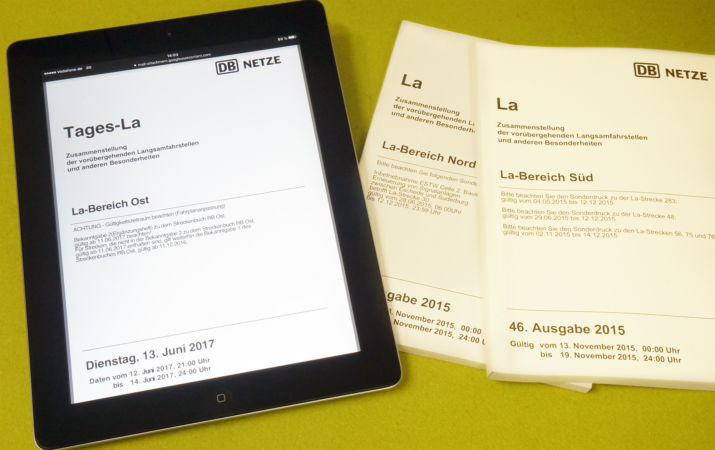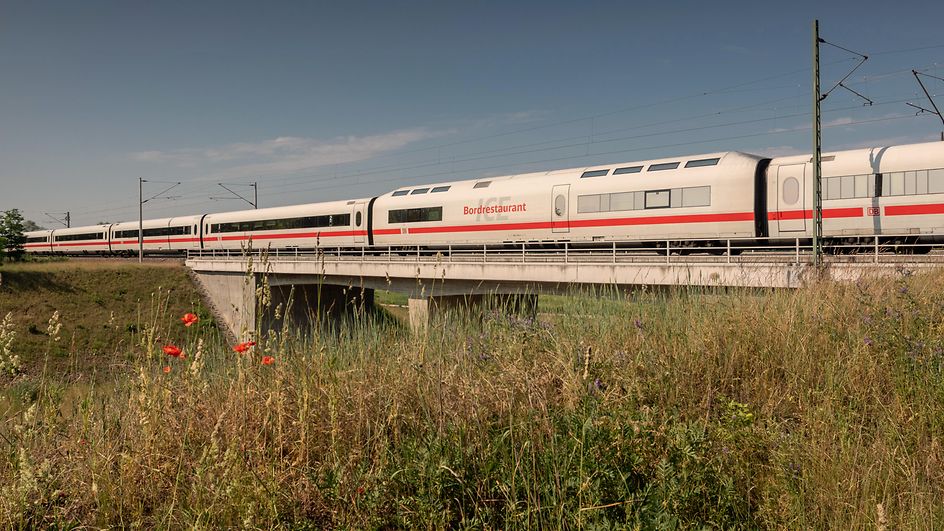Daily information on speed restriction sections
Article: Goodbye to paper as digital documents take priority
07/2017 – From weekly to daily, and paper to digital documents: thanks to digitalisation, information about speed restriction sections can now be sent more quickly, more cost-effectively and more flexibly
Even the best railway network needs to be maintained from time to time. But there are other reasons that trains may have to reduce their speed on certain track sections, such as particular level crossings or vehicle classes. Of course, all railway companies (RCs) that use the lines in question must be informed of these restrictions in good time. Short-term information about temporary speed restrictions and related issues is compiled into a speed restriction list. This information is relevant for train drivers, who need to consult it during journeys. Until now, DB Netz AG has published this information as a weekly printed list of around 100 to 150 pages, which it distributes free of charge to all 400 railway companies that use its lines, including DB Cargo AG, DB Fernverkehr AG, DB Regio AG and external railway undertakings.
In the digital era, however, this approach is extremely ineffective. First, it is, and will continue to be, extremely expensive to produce these documents. Second, it is no longer in keeping with the times to publish this information on a weekly basis. The data for the weekly speed restriction list must be entered well in advance, sent for printing, printed, and distributed – all of which takes around three weeks. Publishing a digital speed restriction list on a daily basis reduces the editing time significantly. It is even possible for the person creating the speed restriction list to make changes to the documents in the afternoon that are visible by 21:00 on the same day.
More speed for less money
But it’s not just about speed. “Until now, DB Netz has been providing the printed speed restriction list to all railway companies free of charge, which has been costing us money,” says Dr Antje Oetting of DB Netz AG, the functional project manager. But this means time-consuming processes for clients too. The lists have to be brought to the drivers and any corrections have to be entered manually by the drivers. For this reason, clients would like to be able to provide drivers with this data electronically and eliminate the cost-intensive and inconvenient processes involved in distributing and correcting printed speed restriction lists.
At first glance, the switch from a weekly printed list to a daily file format does not appear to be particularly complicated: after all, any computer can produce a PDF file at the push of a button. However, even though the underlying process has not changed significantly, specific aspects of the digitalisation process and the optimisations have generated some additional outlay. “As is so often the case, the devil is in the detail,” says Dr Stephan Gogoll, project manager at DB Systel. He and his team are responsible for the concept and its implementation. A daily digital speed restriction list differs significantly from a weekly printed list right from the outset. For instance, a day does not correspond exactly to the day represented in the list. The daily speed restriction list starts three hours before the date in question and includes the information for the entire following day.
Drivers therefore need to check carefully which speed restrictions apply to which days. Some speed restrictions are valid only on certain days of the week, and this can be displayed much more clearly using a daily speed restriction list. Because of the higher publication frequency, the fully automated generation and dispatch of the daily speed restriction list requires a much more extensive automatic decision, logging and notification process than the manual editing steps required for the weekly printed lists.
The document has also been upgraded from a technical perspective. “It is now an electronic document that drivers use on a tablet. Instead of having to browse through the document during the journey, drivers can use skip marks to jump to the relevant passage,” says Dr Stephan Gogoll. In addition, variable control options have been implemented for functional operation, which can be used to set the editorial deadlines and automatic publication date, for example. But most importantly, new interfaces had to be created. DB Netz AG and DB Systel collaborated constructively during all phases of the project, particularly testing, to achieve this.
Portal for registered users
In future, the daily speed restriction list will be distributed via a new SharePoint portal. Users can log on to the portal using their personalised account and subscribe to the speed restriction list documents that they require. The daily speed restriction lists will be available in two file formats on the portal: PDF and XML. “Because the development level of IT technology varies throughout the 400 railway companies, we offer the data in two basic formats: a visually readable variant and a machine-readable variant,” explains Yin Chen from DB Netz AG, project manager for the SharePoint portal. The PDF files can be opened and used immediately by the recipient on any end user device, without any specific technical prerequisites. The XML document can be used by the railway companies for subsequent automatic applications of the list. These files open up a range of options for the railway companies. For example, if they travel only on a specific section of the line, they can process this specific section alone. Publishing the daily speed restriction list in both file formats provides all parties involved with the highest possible degree of flexibility.
Within a year, not only has an additional digital daily version of the weekly printed speed restriction list with extra features been created, but a communication platform has been established that can also be enhanced with other applications in the future. Even a link to the new Open API platform is currently being discussed.
To coincide with the next schedule change in December 2017, the daily speed restriction list will become the primary source of information. Until then, rail companies still have the option to receive the printed weekly version free of charge. Following completion of the test phase, they will have to pay for the printed version. “As we see it, the daily list is already being used by the large railway companies because it works so well,” says Dr Antje Oetting from DB Netz AG. This doesn’t surprise us, since its significant benefits are clear to all involved.



